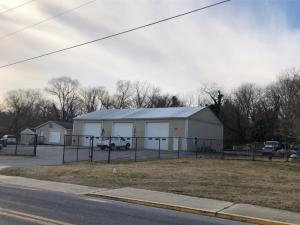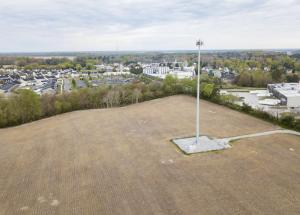Milton planners approve preliminary plans for cell tower

Milton Planning and Zoning Commission, by a 6-1 vote, approved preliminary site plans for Verizon to build a cellphone tower at town property on Front Street.
The Nov. 16 ruling was not without its share of criticism, as residents spoke for nearly two hours questioning the need for the tower at that specific site, its effect on neighborhood home values and its location within a designated floodplain.
To address those concerns, the commission attached a series of conditions that must be met prior to final approval, including a geotechnical analysis of the site in both wet and dry conditions, permits from the U.S. Army Corps of Engineers, a sequence of construction, no pile-driving allowed, an analysis of runoff and flooding, vibration monitoring, and a promise that Verizon will maintain plantings around the site.
Those conditions were arrived at after an occasionally contentious public hearing at Grace Church, which served as the main vehicle for the public to comment on the proposed tower.
The project has been controversial since it first came before the commission earlier this year. Verizon is planning to build a 140-foot tower with a base at the town’s current public works yard at 210 Front St. The first step in the process was getting a special permitted use from the commission, required because the land is located in an R-1 residential district. Citizens opposed the tower then, saying while they supported Verizon’s goal of improving cell coverage in Milton, they did not like the location, which is in an area of town that often floods.
After the commission granted the special permitted use by a 5-2 vote, that decision was appealed to Milton Town Council by Mill Street resident Barry Goodinson. Council upheld the commission’s decision, saying the vote was made in a logical and informed manner, although it should be noted council voted on the narrow parameter of whether the commission made its ruling after a thorough investigation, not whether they approved of the project or not.
With the special permitted use in place, Verizon came to the commission for the second part of the process, preliminary site-plan review, where the commission examines an application to ensure it meets the standards of town code.
Attorney John Tracey, representing Verizon, said the tower complex would consist of a monopole mounted to a raised platform that would be 7 feet above grade, 2 feet above the flood elevation. The complex would have a half-paved, half-gravel driveway leading to the pole, and the pole itself would be screened by eastern red cedar trees and fencing. Tracey said technicians would visit the site every six weeks to ensure the tower’s proper operation.
One of the first questions from the committee was about geotechnical studies of the site, which would analyze the soil around the site to ensure it can support the tower. Tracey said those studies would be completed before final site-plan approval. Also, Tracey said approvals from the Army Corps, the Federal Aviation Administration and Federal Communications Commission were in process and would be completed prior to final site-plan approval. Finally, he said Verizon would be responsible for maintaining the trees around the tower.
Public, elected officials speak out
Following Tracey’s presentation, the microphone was turned over to the public.
First up was Councilman Sam Garde, who questioned how the project squared with the town’s floodplain ordinance, asked if other sites were considered and wondered whether conditions attached to the special permitted use had been met by Verizon.
Commission Chair Richard Trask referred him to the commission’s advisory report, which was submitted to town council, and then prepared to read the entire six-page report out loud. Town Solicitor Seth Thompson stopped him there, and read off the conditions with Tracey chiming in as to whether they had been met. In short, some have and some haven’t, in part because some of the conditions could not be met until just prior to final approval, when applicants typically present a fleshed-out version of a project that includes outside agency approvals.
Garde said he still did not understand how the tower was allowed under the floodplain ordinance. Town code says, “No new public or private utility system shall be constructed within any special flood hazard area,” which the Front Street property would qualify as.
Project Manager Tom Quass said his interpretation of the code was that the tower was not a utility system, but a standalone, monopole tower. Garde and another speaker, Allen Sangree of Union Street, disagreed with that assessment, saying a cellphone tower is a utility system.
Goodinson also questioned Quass’ interpretation, and also wondered what the fencing around the tower was actually accomplishing.
“This whole thing is completely unnecessary,” he said.
Goodinson showed photographs he had taken from late October showing Front Street completely flooded in the area of the proposed tower, and questioning how Verizon would service the tower under those conditions.
“This is going to be a problem,” he said.
Several commenters wondered why alternative sites were not explored.
Councilman John Collier said he did not agree that the tower should be located there. Allan Benson of Collins Street said the tower would have a negative impact on the surrounding neighborhood.
Ginny Weeks of Clifton Street said, “This will be an eyesore beyond belief. This is not what the people want.”
Beth Dangler of Federal Street and Bettie Orr of Mill Street both said they did not believe the tower had to be in that area or even in town at all, citing the AT&T tower off Cave Neck Road. The Verizon tower would only serve Verizon customers. Commenters also asked why Verizon did not consider mounting equipment on the town’s water tower on Chandler Street. Tracey said town officials had told Verizon they did not want cellular equipment on the water towers.
Jeff Evans of Walnut Street said he did not understand why people couldn’t just switch to AT&T or Xfinity for their cell service, and questioned why Verizon could not just use AT&T’s equipment. Andrew Thompson, Verizon’s engineer, said one reason why not is because using another tower would not address radio frequency issues getting coverage to Verizon customers.
With the atmosphere getting combative, Trask announced that one more speaker would be heard before the public comment period ended. However, Thompson told him that because this was a public hearing, all comments had to be heard.
After two hours of testimony and a 10-minute break, the commission reconvened and agreed to move the cell tower project forward to the next steps, with the conditions attached. The only no vote was Commissioner Lynn Ekelund, who also had voted against the special-use permit for the tower.


















































